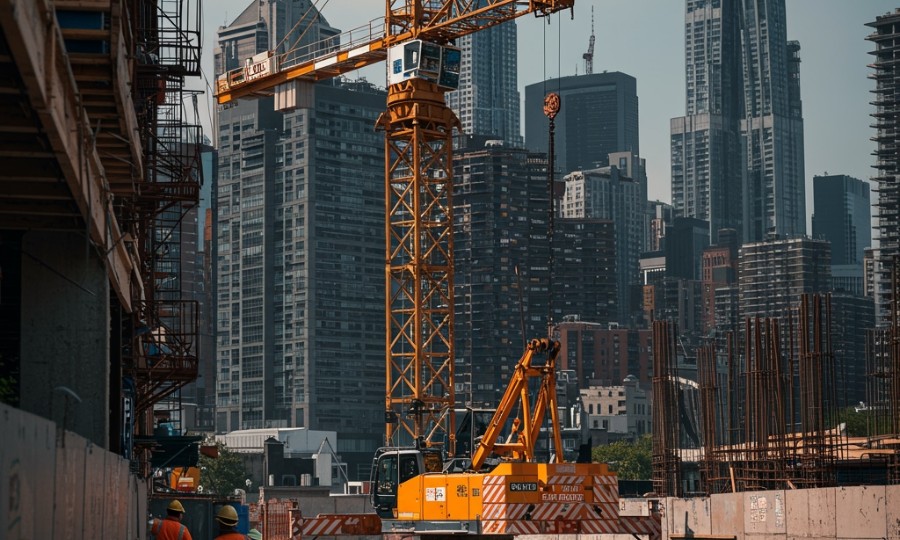
Have you ever paused to truly consider the sheer scale and potential peril of the cranes towering over our city? From the familiar hum of construction to the impressive dance of steel beams against the Brooklyn skyline, heavy equipment is an undeniable part of our urban landscape. But beneath that visible progress lies a less discussed, yet critically important, reality: the escalating dangers associated with crane and heavy equipment accidents. We’re not just talking about minor mishaps here; we’re talking about serious incidents that can forever alter lives, and frankly, they’re happening more often than you might think.
Brooklyn, with its relentless pace of development, has become a microcosm of this trend. Every new high-rise, every renovated brownstone, every infrastructure project relies on these colossal machines. While they’re essential for building our future, they also introduce significant risks. The truth is, recent reports and official data from bodies like the New York City Department of Buildings (DOB) and the Occupational Safety and Health Administration (OSHA) highlight a disturbing pattern of crane and heavy equipment incidents across NYC, with Brooklyn seeing its share. It’s a professional and engaging topic that demands our attention, wouldn’t you agree?
Unpacking the Common Culprits Behind Heavy Equipment Accidents
So, what exactly is contributing to these alarming incidents? It’s rarely one single thing; usually, it’s a confluence of factors, each with serious implications. Understanding these common culprits is the first step toward prevention.
Mechanical Failure: When Machines Betray Trust
Imagine a massive crane, lifting tons of steel, suddenly failing. It’s a terrifying thought, but mechanical failures are a real, albeit often preventable, cause of accidents. This can range from a snapped cable or a faulty hoist to a structural defect in the boom itself. Usually, these issues stem from inadequate maintenance, wear and tear that goes unnoticed, or using equipment past its safe operational life. OSHA regulations, for instance, are very clear about the need for regular, thorough inspections by qualified personnel. Ignoring a manufacturer’s recommended service schedule isn’t just cutting corners; it’s inviting catastrophe. Do you ever wonder if the equipment you see daily has been properly maintained?
Overloading: Pushing the Limits, Paying the Price
Heavy equipment, by its very nature, has strict operational limits. Overloading occurs when operators attempt to lift or move loads that exceed the machine’s rated capacity. This isn’t always intentional; sometimes it’s a miscalculation, other times it’s pressure to speed up a project. But the consequences are devastating. Overloading can lead to structural collapse, tip-overs, or failure of critical components. It’s a direct violation of safety protocols and, frankly, common sense. Site safety plans and operator training should always emphasize adherence to load charts and proper weight assessment. In my experience, cutting corners here is one of the quickest ways to invite disaster.
Contact with Power Lines: An Electrifying Danger
This is one of those dangers that can feel almost invisible until it’s too late. Coming into contact with overhead power lines is an incredibly serious hazard, often leading to electrocution for operators and anyone in the vicinity. Many construction sites, even in bustling Brooklyn, are surrounded by active power lines. OSHA mandates a minimum clearance distance (often 10 feet or more, depending on voltage) between equipment and power lines, and it’s a rule that simply cannot be bent. You might think, ‘How could someone miss a power line?’, but in the busy, dynamic environment of a construction site, with multiple moving parts and distractions, it unfortunately happens.
Operator Error and Inadequate Training: The Human Factor
Even the most perfectly maintained equipment can become dangerous in the wrong hands. Operator error, stemming from insufficient training, lack of experience, or even momentary lapses in judgment, is a significant contributor to accidents. Operating heavy machinery requires specialized skills, certification, and a deep understanding of safety protocols. The NYC DOB has stringent licensing requirements for crane operators for a reason. If an operator isn’t properly trained, isn’t familiar with the specific equipment they’re using, or is pressured to work unsafely, the risks skyrocket. We know this feels overwhelming, but ensuring everyone on site is properly credentialed and regularly refreshed on safety procedures is absolutely crucial.
The Devastating Ripple Effect: Consequences for Workers and Bystanders
When a crane or heavy equipment accident occurs, the impact extends far beyond just the immediate site. The consequences are often severe, affecting not only the workers directly involved but also innocent bystanders and the broader community.
Worker Injuries and Fatalities: A Life-Altering Impact
For construction workers, these accidents can be catastrophic. We’re talking about crushing injuries, severe falls from height, electrocution, amputations, and traumatic brain injuries. These aren’t just statistics; they’re individuals whose lives are forever changed, often left with permanent disabilities, unable to return to work, and facing immense physical and emotional trauma. Families are torn apart. The financial burden of medical bills, lost wages, and long-term care can be staggering, even with workers’ compensation. It’s a somber reality that underscores why robust safety measures aren’t just good practice; they’re a moral imperative.
Bystander Risk: The Unseen Victims
In a densely populated borough like Brooklyn, a heavy equipment accident isn’t contained to the job site. Falling debris, collapsing structures, or even a runaway piece of machinery can pose an extreme threat to pedestrians, nearby residents, and property. We’ve seen tragic instances where crane booms have collapsed onto streets, damaging vehicles and injuring or killing people who were simply going about their day. This highlights a critical public safety concern that city officials and construction companies must prioritize. You might be thinking this won’t work because of the fast pace of construction, but shouldn’t public safety always be the paramount concern?
Financial and Legal Fallout: A Costly Aftermath
Beyond the human toll, these incidents carry immense financial and legal ramifications. Construction companies can face hefty fines from regulatory bodies like OSHA and the DOB, significant lawsuits from injured workers and affected bystanders, and project delays that cost millions. There’s also the irreparable damage to a company’s reputation and the potential for increased insurance premiums. The cost of prevention, while substantial, almost always pales in comparison to the costs incurred after a serious accident.
Proactive Steps: Strengthening Safety Protocols and Accountability
Given the severe risks, what can be done to reverse this dangerous trend and enhance safety across Brooklyn’s bustling construction sites? It’s going to take a multi-faceted approach, combining stringent regulations with a culture of unwavering commitment to safety.
Enhanced Inspections and Maintenance Regimes
First, let’s look at more frequent and more thorough inspections. This isn’t just about ticking boxes; it’s about detailed, professional evaluations of every piece of equipment, from the smallest forklift to the tallest tower crane. Implementing robust preventative maintenance schedules, adhering strictly to manufacturer guidelines, and documenting every check and repair are non-negotiable. The NYC DOB often conducts unannounced inspections, which are crucial, but internal site inspections need to be equally rigorous.
Robust, Ongoing Training and Certification
Then we’ll explore training. It’s not a one-and-done deal. Operators need comprehensive initial training, followed by regular refresher courses that cover new technologies, updated regulations, and best practices. Scenario-based training can help operators react appropriately in high-stress situations. Also, clear communication protocols between operators, signal persons, and site supervisors are essential to prevent miscommunications that can lead to accidents. Wouldn’t a stronger focus on continuous education save lives and livelihoods?
Leveraging Technology and Data for Better Oversight
Modern technology offers powerful tools for enhancing safety. Telematics systems can monitor equipment usage, identify potential mechanical issues before they become critical, and even track operator behavior. Drones can assist with site inspections, especially in hard-to-reach areas, and provide valuable data for safety planning. Implementing these technologies isn’t just about efficiency; it’s about creating a smarter, safer work environment.
Culture of Safety and Accountability
Ultimately, safety isn’t just about rules and equipment; it’s about people and culture. Every individual on a construction site, from the project manager to the newest laborer, must prioritize safety. This means empowering workers to speak up about unsafe conditions without fear of reprisal, holding management accountable for fostering a safe environment, and continuously reinforcing the message that no deadline is worth risking a life. NYC’s construction safety laws are among the toughest in the nation, but their effectiveness relies on diligent enforcement and a shared commitment to safety from everyone involved.
The dangers above are real, and the trend of crane and heavy equipment accidents in Brooklyn and across NYC is a serious concern. It’s a stark reminder that while progress is vital, it must never come at the expense of human safety. By understanding the common causes, acknowledging the devastating consequences, and committing to proactive measures, we can work towards a future where our city’s skyline rises without fear. Let’s all advocate for stronger safety, because every life matters.
Free Case Consultation
Injured in an accident? Contact Rosenberg, Minc, Falkoff & Wolff for a free and confidential case review with an experienced NYC personal injury attorney.


